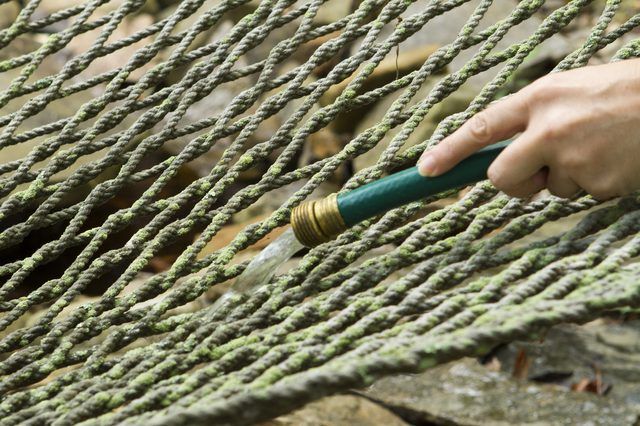Bulbs
Flower Basics
Flower Beds & Specialty Gardens
Flower Garden
Garden Furniture
Garden Gnomes
Garden Seeds
Garden Sheds
Garden Statues
Garden Tools & Supplies
Gardening Basics
Green & Organic
Groundcovers & Vines
Growing Annuals
Growing Basil
Growing Beans
Growing Berries
Growing Blueberries
Growing Cactus
Growing Corn
Growing Cotton
Growing Edibles
Growing Flowers
Growing Garlic
Growing Grapes
Growing Grass
Growing Herbs
Growing Jasmine
Growing Mint
Growing Mushrooms
Orchids
Growing Peanuts
Growing Perennials
Growing Plants
Growing Rosemary
Growing Roses
Growing Strawberries
Growing Sunflowers
Growing Thyme
Growing Tomatoes
Growing Tulips
Growing Vegetables
Herb Basics
Herb Garden
Indoor Growing
Landscaping Basics
Landscaping Patios
Landscaping Plants
Landscaping Shrubs
Landscaping Trees
Landscaping Walks & Pathways
Lawn Basics
Lawn Maintenance
Lawn Mowers
Lawn Ornaments
Lawn Planting
Lawn Tools
Outdoor Growing
Overall Landscape Planning
Pests, Weeds & Problems
Plant Basics
Rock Garden
Rose Garden
Shrubs
Soil
Specialty Gardens
Trees
Vegetable Garden
Yard Maintenance
Removing Algae and Mildew Stains From a Hammock
Removing Algae and Mildew Stains From a Hammock. A hammock may be your favorite place to relax outdoors, but it requires a bit of maintenance and upkeep, eventually. Mildew grows in humid, damp environments, which can include outdoor fabrics. Algae from nearby trees may leave stains on the hammock. A thorough treatment with vinegar and soapy water...
A hammock may be your favorite place to relax outdoors, but it requires a bit of maintenance and upkeep, eventually. Mildew grows in humid, damp environments, which can include outdoor fabrics. Algae from nearby trees may leave stains on the hammock. A thorough treatment with vinegar and soapy water renders the hammock mildew- and algae-free once again. Bypass the chlorine bleach when cleaning your hammock, as it may compromise the fabric.
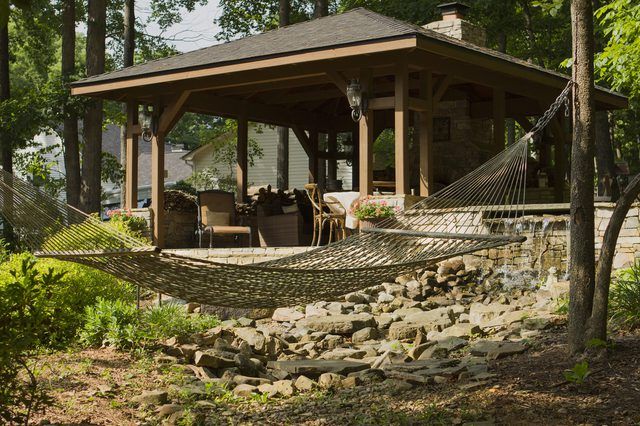
Things You'll Need
Scrub brush
Dust mask
White vinegar
Baking soda
Shallow bowl
Water
Mild dish soap
Oxygen bleach
Step 1
Brush the algae or mildew stains and spots on the hammock with a scrub brush while the hammock is hanging in its usual area. Wear a dust mask while brushing to avoid breathing in mildew spores, which may aggravate allergy and asthma symptoms. Do this while the hammock is dry; if wet, allow it to dry out completely.
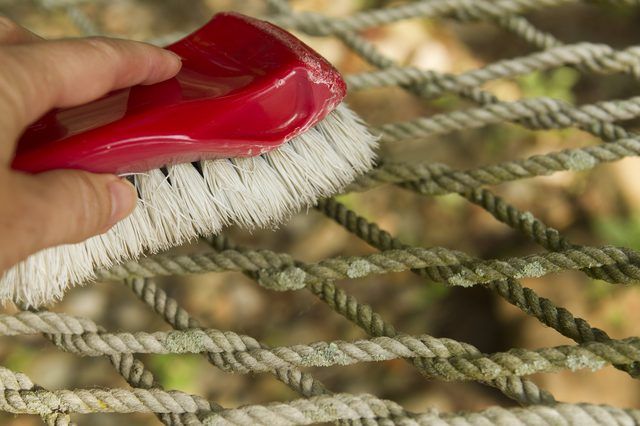
Step 2
Flip the hammock over to inspect the underside, brushing away any mildew or algae spots you find. Enlist the help of a friend if it is difficult to keep the hammock turned sideways or upside-down.

Step 3
Pour a small amount of white vinegar over each stain. Allow the hammock to soak for 10 or 15 minutes, ideally in direct sunlight.
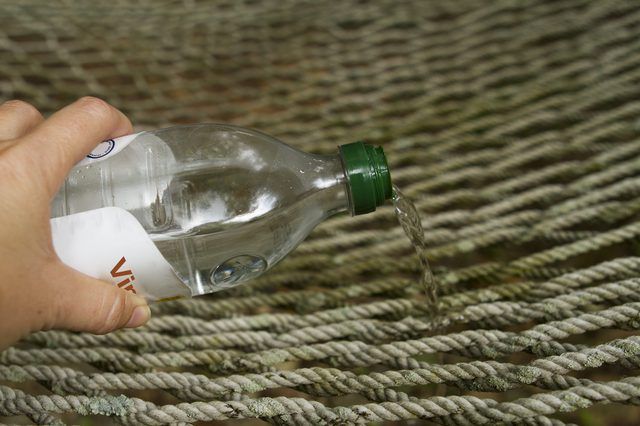
Step 4
Rinse off the scrub brush to remove any dry mildew or algae particles; then scrub the spotted areas on the hammock. Rinse the brush from time to time if scrubbing many spots to avoid spreading debris and dirt.
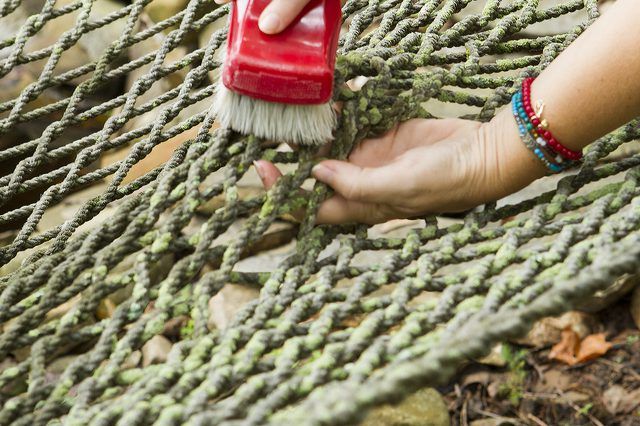
Step 5
Sprinkle a little baking soda over the spots if they still exist. Scrub with the scrub brush after several minutes. Rinse the scrub brush.
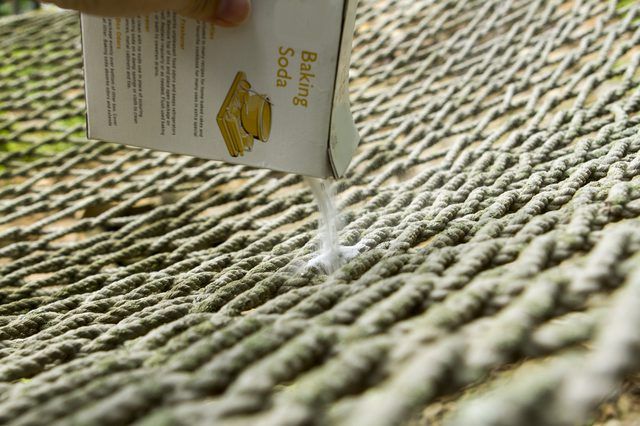
Step 6
Fill a shallow bowl with warm water and add a squirt of a mild dish soap. Mix the water with your hands; then dip the scrub brush into the soapy water. Scrub the spots with the soapy water, and rinse it with a garden hose. Avoid spraying the spreader bars or hooks that hold up the hammock.
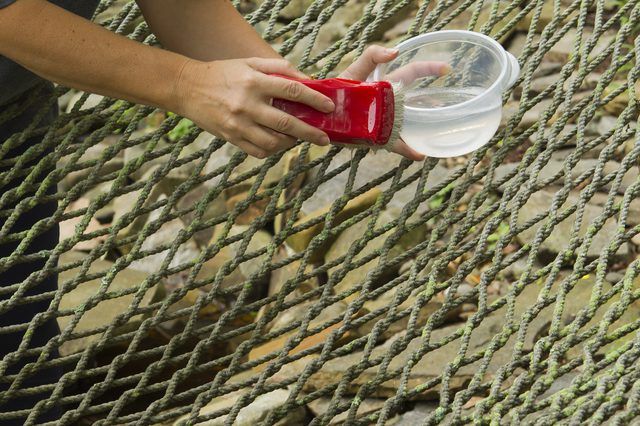
Step 7
Mix an oxygen bleach into a bowl of water using the proportions recommended on the package for difficult stains if spots are still present. Oxygen bleaches use oxygen to remove stains, rather than chlorine-style bleaching agents.
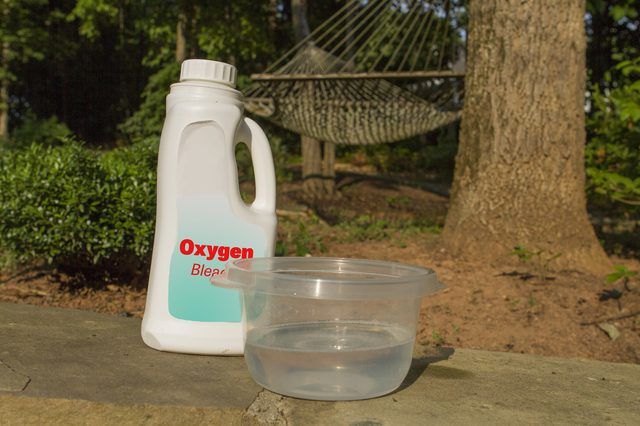
Step 8
Dip the scrub brush into the oxygen bleach solution and scrub the spots on the hammock. Wipe the solution away with a damp sponge or with a rinse with a garden hose. Allow the hammock to air dry completely in a well-ventilated area.
